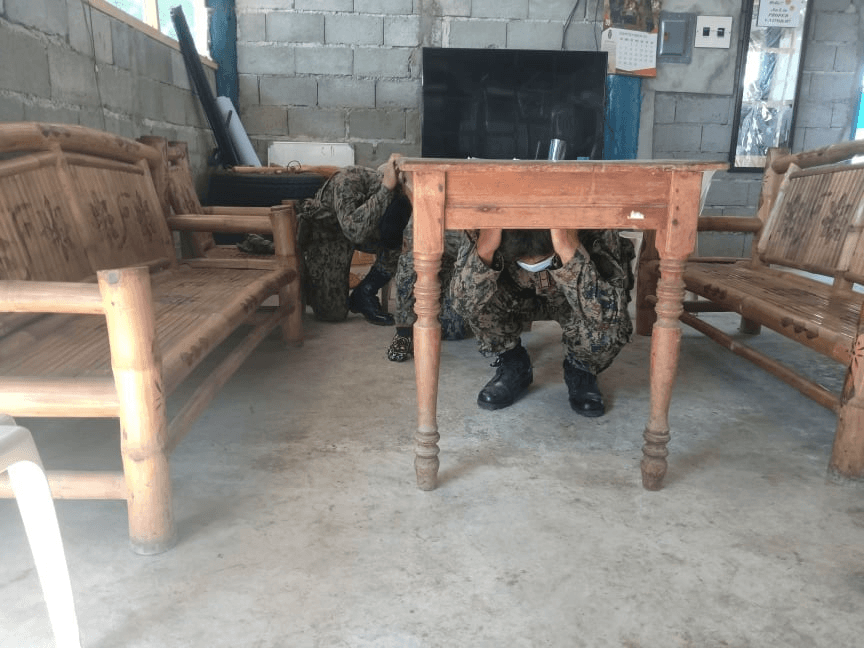SUMMARY
This is AI generated summarization, which may have errors. For context, always refer to the full article.

Natural disasters can strike at any time, even in the middle of a pandemic.
Filipinos witnessed this as several areas in the country suffered earthquakes on top of dealing with the COVID-19 pandemic. In August, a magnitude 6.6 earthquake struck Masbate, leaving one man dead, many others injured, and several buildings damaged.
To help Filipinos prepare for earthquakes during the pandemic, the Office of Civil Defense (OCD), in partnership with the Department of Science and Technology-Philippine Institute of Volcanology and Seismology (DOST-Phivolcs) and the Department of the Interior and Local Government (DILG), shared tips on how to stay safe during a disaster, in a webinar on Tuesday, September 8.
Earthquake preparedness tips during a pandemic
DOST Undersecretary Renato Solidum Jr, who is Phivolcs Officer-in-Charge, said earthquake evacuation should be prioritized over a stay-at-home order if the situation calls for it. He also gave the following tips:
- Prepare an emergency survival bag or “Go Bag” containing health-related personal protective equipment such as face masks and sanitation solutions, and other essentials for survival including easy-to-prepare and non-perishable food
- In the event of an earthquake, “drop, cover, and hold” until the shaking stops
- When vacating a building after an earthquake, remember to bring your “Go Bag” and wear a face mask
- As much as possible, physical distancing of at least one meter must be observed throughout the evacuation


“Huwag magkumpulan, may safe physical distancing. Ang maigi, kung masyado maraming tao, per family ang ating grouping para hindi magkahawaan,” Solidum advised.
(Don’t crowd in one place, there should be safe physical distancing. Better yet, if there are too many people, group yourselves by family to avoid infecting others.)
Those who are outdoors must wait for the advisory of building management and local authorities before returning indoors.
Earthquake preparedness activities go virtual
People may also join the quarterly earthquake drills of the National Disaster Risk Reduction and Management Council (NDRRMC) to learn more about disaster preparedness.
Dubbed the nationwide simultaneous earthquake drill (NSED), the quarterly exercise typically puts in practice evacuation procedures following simulated scenarios, and other safety measures to strengthen citizens’ disaster response and earthquake preparedness.
However, the first NSED for 2020 originally scheduled on March 12 was canceled to “ensure public health safety of the drill participants and to prevent the possible risk of contracting COVID-19.”
Since then, the NDRRMC has put the NSED on hold due to the public health emergency.
After the country experienced several earthquakes in various parts of the country – including a magnitude 6.1 earthquake in Sarangani in late March and magnitude 5.7 eathquake in Surigao del Sur in July – the NDRRMC revised the quarterly drills by bringing them online in September.
The NDRRMC will conduct the 3rd quarter NSED at 2 pm on Thursday, September 10. Meanwhile, the 4th quarter NSED is slated for November 12 at 9 am.
During the pandemic, the hosting of the NSED at national and regional ceremonial sites will be suspended. Instead, the NDRRMC will organize an information, education, and communication campaign entirely through social media platforms to update disaster response plans considering the pandemic.
The OCD will hold a Facebook Live streaming of the ceremonial pressing of the button to signal the practice of “duck, cover, and hold” procedures for participants at home, in offices and institutions.
Other stakeholders may also implement other exercises such as drills and functional exercises using online tools. Participants may also undergo a tabletop exercise, which is a facilitated discussion tackling what one would do in a simulated disaster scenario.
The public is invited to watch the live stream and participate in the online NSED by following the drills inside the safety of their homes or offices.
The OCD hopes that these efforts will help local government units and Filipinos in reviewing disaster mitigation strategies in light of the pandemic.
“While local government units are mandated to be at the front lines of DRRM, we need to adjust and shift our focus na dapat ang pamilyang Pilipino ay mga frontliners din na maituturing. Hindi lamang sa COVID-19, pero pati na rin sa paghahanda sa iba’t ibang sakuna,” said Rachelle Anne Miranda, Officer-in-Charge of OCD’s information, training and advocacy division.
(Filipino families should also be considered frontliners not only against COVID-19, but also in preparing for different disasters.) – Rappler.com
Add a comment
How does this make you feel?


![[Time Trowel] Evolution and the sneakiness of COVID](https://www.rappler.com/tachyon/2024/02/tl-evolution-covid.jpg?resize=257%2C257&crop=455px%2C0px%2C1080px%2C1080px)


There are no comments yet. Add your comment to start the conversation.